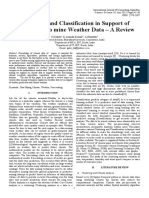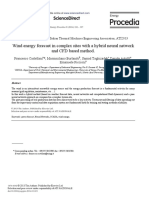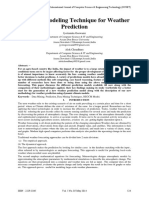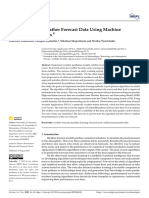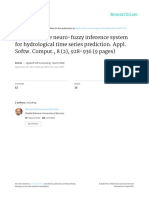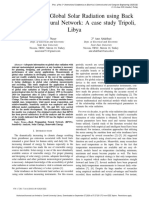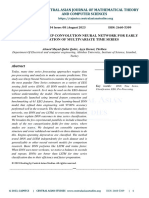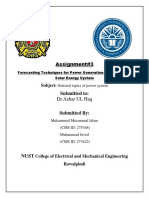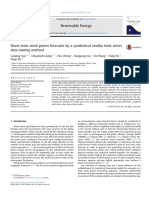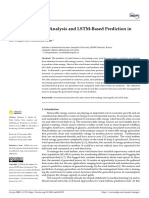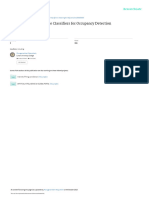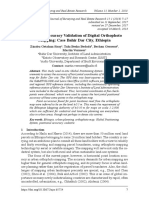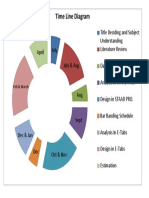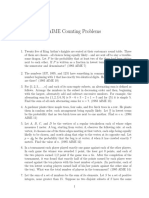Professional Documents
Culture Documents
K-Means Clustering and Artificial Neural Network in Weather Forecasting
Original Title
Copyright
Available Formats
Share this document
Did you find this document useful?
Is this content inappropriate?
Report this DocumentCopyright:
Available Formats
K-Means Clustering and Artificial Neural Network in Weather Forecasting
Copyright:
Available Formats
Volume 8, Issue 11, November – 2023 International Journal of Innovative Science and Research Technology
ISSN No:-2456-2165
K-Means Clustering and Artificial Neural Network in
Weather Forecasting
Shubham Choramle; Jaydeep Lokhande; Vidwesh Choudhary; Pruthviraj Mohalkar; Dr. Vitthal Gutte
Department of Computer Engineering and Technology, Dr. Vishwanath Karad MIT WPU University
Address: MIT World Peace University, Sr No 124, Ex Serviceman Colony, Paud Road, Kothrud, Pune-411038
1032210941@mitwpu.edu.in TO jaydeeps.lokhande@gmail.com
1032210967@mitwpu.edu.in TO vidweshchoudhary@gmail.com
1032210657@mitwpu.edu.in TO shubham.choramle1330@gmail.com
1032210772@mitwpu.edu.in TO pruthvirajmoholkar3@gmail.com
vitthalgutte2014@mitwpu.edu.in TO vitthal.gutte@mitwpu.edu.in
Abstract- The research paper's abstract provides a brief professional weather predicting services beat the models, they
introduction to the subject of forecasting the weather, may do so over longer time frames. Discussion of the study's
discusses the applications and limitations of K-Means shortcomings and recommendations for further investigation
clustering and ANNs (artificial neural networks) in follow.
weather forecasting, and identifies a comparison of these
two approaches as the primary goal of the study. It finishes In our Paper two Algorithm are being studied 1. K-mean
by highlighting the significance of integrating different Clustering and 2. Artificial Neural Network (ANN) in weather
methodologies for precise weather forecasting and briefly prediction:
referencing relevant work. K-means clustering is a well-liked machine learning
approach that is employed for this purpose. K-means
Keywords:- "Weather Forecasting," "K-Means Clustering," clustering refers to the combining of data points that are
"Artificial Neural Networks," "Ml," "Comparative Analysis," alike without the usage of predetermined labels. In
And "Meteorological Data." conclusion, K-means operates in the way outlined below:
Initialization of the centroids of the 'K' cluster, either
I. INTRODUCTION randomly or by a predetermined method.
Based on distance, frequently using a Euclidean distance
On a mix of meteorological measurements, historical metric, each information point gets assigned to the nearest
weather information, and meteorologists' expertise, classical centroid.
weather forecasting is predicated. This process includes By averaging all the data points assigned to each cluster,
gathering and evaluating data from several meteorology centroids are recalculated.
sources of information, run computerized weather models, and Repeat steps 2 and 3 as necessary to achieve the
employing meteorological expertise to assess the models' appropriate number of iterations or until the centroids
outputs. hardly move at all.
The basic objective of this technique is to generate 'K'
On the other hand, forecasting of weather powered by different clusters of information points by maximising
machine learning makes use of advanced statistical and variance between clusters and minimising variance within
computational techniques. To forecast the weather, it entails clusters. K-means has several uses in picture segmentation,
utilizing machine learning algorithms that have been taught data analysis, and other circumstances where accumulating
from historical weather data. Similar to traditional forecasting pertinent data is important.
methods, machine learning-based systems incorporate
meteorological data from many sources such as weather An Artificial Neural Network (ANN), a type of
stations, satellites, and radar. They could, however, also make computational model, is inspired by how the human brain
use of peculiar data sources, such as social networking sites or works. In a word, an ANN is built up of layered networks
Internet of Things (IoT) devices. of linked nodes, or "neurons," that are coupled to one
another. These layers commonly include an input layer,
[1] The use of predictive machine learning techniques for one or more layers that are hidden, and a layer for output.
weather forecasting is covered in this paper. In particular, the
research investigates how to make use of both linear and An ANN's core components are as follows:
functional regression approaches to forecast the highest and Neurons: These act as computing components that process
lowest temperature for seven consecutive days, given inputs, carry out a weighted summation, and then send the
meteorological information for the previous two days. The output of the result through an activation function.
study's dataset includes meteorological information for Weights: A weight is assigned to each connection between
Stanford, California, spanning the years 2011 through 2015.
neurons, indicating the strength of the relationship.
The article comes to the conclusion that even while
Through exercise, these weights are changed.
IJISRT23NOV669 www.ijisrt.com 459
Volume 8, Issue 11, November – 2023 International Journal of Innovative Science and Research Technology
ISSN No:-2456-2165
A network can model complex interactions within data IV. METHODS
thanks to the non-linearity introduced by an activation
function. It is uncommon to use K-Means clustering directly to
improve weather forecasting accuracy. Instead, it is
An ANN's main goal is to learn from data by minimizing frequently used as a part of a larger data analysis or
prediction errors in classification or regression tasks by preprocessing pipeline, which could indirectly enhance
adjusting the weights during training. ANNs are used in a weather forecasting models. The following elements are
variety of artificial intelligence and machine learning fields, included in K-Means clustering's application to weather
such as image identification, natural language processing, forecasting:
autonomous driving, and many more. Data Preprocessing: K-Means clustering is used in data
preprocessing to find patterns or clusters in historical
II. OBECTIVE meteorological data. The data can be efficiently reduced in
dimension or translated into categorical variables that
To do a comparative analysis of K-Means Algorithm and indicate different weather regimes or conditions by
ANN in Weather Forecasting. grouping together comparable weather patterns. These data
clusters can then act as features for more traditional
III. RELATED WORK weather forecasting models.
Pattern Identification: A useful approach for locating
There are other Machine Learning algorithm aswell repeating weather patterns or anomalies is K-Means
which are also used for weather prediction: clustering. It can be used, for instance, to find trends in
Regression Models: Linear and polynomial regression are historical data on temperature, humidity, or air pressure.
effective methods for identifying relationships between Meteorologists' decision-making is improved and their
meteorological variables. By examining historical data understanding of the current meteorological conditions is
together with variables like humidity, air pressure, and time deepened by their ability to recognize these patterns.
of day, they help predict temperature, for example. Compression of data: K-Means clustering can sometimes
Time Series Analysis: Time series analysis methods, such be used to efficiently compress large amounts of weather
as ARIMA (AutoRegressive Integrated Moving Average), data into a more manageable size. This is very useful for
are used in the field of weather forecasting to predict and efficient data transmission and storage, especially in
foresee trends, seasonality, and irregular variations in remote areas or with limited resources.
weather-related data. Feature Engineering: The use of clustering outcomes as
Random ForestRandom Forest is an ensemble learning features in more intricate machine learning models, such
approach that excels at handling regression as well as as random forests, decision trees, or neural networks,
classification issues when used for weather forecasting. It enhances weather forecasting. When analyzing the data
may be used to forecast various meteorological conditions, using the raw data, it might be challenging to spot hidden
such as rainfall or the possibility of storms. links or trends in the data. These qualities may help you do
Support Vector Machines (SVM): Based on historical data just that.
and input features, SVMs are used for classification tasks Data Quality Control: K-Means clustering can be used to
like predicting the likelihood of various weather events identify irregularities or anomalies in meteorological data,
(like rain or snow). assisting in the detection of measurement errors or
Decision Trees: Decision trees can be used to categorize inconsistencies in the dataset. Data quality assurance. This
weather events and make decisions related to them, such as procedure is important for improving the precision of the
determining if inclement weather at an airport would cause data used as input for prediction models.
aircraft delays.
Ensemble Methods: To increase forecasting accuracy, While numerical weather prediction (NWP)
multiple machine learning models are combined using mathematical models, data assimilation techniques, and the
techniques like AdaBoost and Gradient Boosting. addition of different sources of data, like data from satellites,
Models for numerical weather prediction (NWP) The weather observatories, and radar, are the main ways to
complicated mathematical and physical models used in improve forecast accuracy, K-Means clustering can
NWP models, which are not ordinary machine learning nonetheless indirectly improve weather forecasting.
techniques, recreate atmospheric phenomena. They play a
significant role in weather forecasting. [2] The simulations presented in the research are built
Deep Learning for Image Analysis: Convolutional Neural using data from 2009 and 2010. The simulation is carried out
Networks are used for image analysis in the field of to determine the precision of the strategy suggested in the
weather forecasting, particularly the recognition of cloud study. The experiment is carried out using Java and the Weka
cover in satellite photos. software on a PC with a 2.26 GHz Core i3 processor and 4GB
of memory running Windows 7 Home Basic. Any method's
accuracy can be evaluated by contrasting its present value with
its real value. The simulation outcomes demonstrate the
excellent accuracy rate of the suggested incremental K-means
clustering method for weather forecasting. By contrasting the
actual weather with the forecasted weather, the accuracy of the
IJISRT23NOV669 www.ijisrt.com 460
Volume 8, Issue 11, November – 2023 International Journal of Innovative Science and Research Technology
ISSN No:-2456-2165
strategy is evaluated. As a result of the findings, it can be ensemble of models or act as a component inside a broader
concluded that the methodology for forecasting weather is weather forecasting system.
highly accurate. The suggested approach can be strengthened Integration: By combining several models and data inputs,
even more by utilizing more sophisticated methodologies and a comprehensive weather forecasting system can be
algorithms, according to the paper. The creation of more created using the forecasts generated by an artificial neural
sophisticated weather forecasting algorithms and methods, network (ANN). The use of ANNs as one tool among many
which can be utilized to increase the suggested methodology's in a varied toolkit is a common ensemble method in
accuracy, is part of the planned work's future scope. modern weather forecasting.
Real-time Data: Current information from weather
The accuracy of the suggested approach for forecasting stations, satellites, and other sources is essential for
the weather using incremental K-mean clustering was accurate weather forecasting. ANNs are able to
calculated to be around 83.3%. By comparing the true worth continuously examine new data and update their
with the present value of the new approach, the accuracy was predictions in light of the most recent information.
calculated. The simulation results demonstrate the high
accuracy rate of the suggested methodology, which makes it a
trustworthy tool for weather forecasting.
Fig 2 ANN Flow Chart
[4] The use of a back propagation neural network system
to forecast rainfall in India is discussed in this paper.
According to the authors, 52% of all jobs in India are in the
agricultural sector, making it the country's most common
occupation. However, there are insufficient irrigation
Fig 1 K-Means Flow Chart infrastructure, since only 52.6% of the area was irrigated in
2009–2010. As a result, farmers continue to rely largely on
Artificial Neural Networks (ANNs) have been applied to rainfall, especially during the monsoon season. Therefore, it is
weather prediction tasks Although they are only one essential for agriculture planning and management to estimate
component of complex weather forecasting models, rainfall accurately.
artificial neural networks (ANNs) find uses in weather
prediction tasks. The following is an outline of how ANNs For data mining, a form of supervised machine learning
are used in weather prediction: method is used: the back propagation neural network model.
Data Input: The historical weather data used to train ANNs In this instance, moisture, dew point, and atmospheric pressure
includes elements like temperature, humidity, wind speed, data are used to train the model in order to forecast rainfall.
atmospheric pressure, and more. These informational Using 250 patterns for training and 120 testing patterns, the
components act as the neural network's input features. authors divided their data in half for training and the other third
Output: Depending on the precise task at hand, the ANN's for testing. They claim to have achieved testing accuracy of
output in the context of weather prediction may vary. It 94.28% and training accuracy of 99.79%.
could entail predicting future values for variables like
temperature, precipitation, wind patterns, or even [3] The usage of artificial neural networks, or (ANN) for
categorizing weather as "rainy" or "sunny." weather forecasting is discussed in the paper. It emphasizes
Training: The Artificial Neural Network (ANN) is trained that owing to the irregular nature of weather, conventional
using historical data as well as observed weather techniques of forecasting the weather have limits and that
conditions. The main goal is to optimize the weights and ANN can offer more precise forecasts by learning from prior
biases of the network so that it can produce accurate data and modifying its parameters. The PDF also includes
predictions based on the input data. examples of research on temperature, a thunderstorm, rain, and
Model Complexity: Weather forecasting is fundamentally weather in particular places. These works are all examples of
complex since it takes into account a wide range of research on predicting weather using ANN. The PDF comes to
variables, including atmospheric dynamics, geographic the conclusion that ANN is an effective tool for weather
characteristics, and other elements. To properly handle this prediction and may be used in place of conventional
complexity, ANNs can be incorporated into a thorough meteorological methods.
IJISRT23NOV669 www.ijisrt.com 461
Volume 8, Issue 11, November – 2023 International Journal of Innovative Science and Research Technology
ISSN No:-2456-2165
[5 ] They have presented a temperature forecast model [10] In a city catchment in west Sydney, Australia,
that makes use of advanced wireless data gathering techniques. artificial neural networks, or ANNs, are used to forecast
This model mixes artificial neural networks with the strength rainfall, as discussed in the paper file. Based on previously
of statistical software. An artificial neural network integrates known geographical and temporal rainfall patterns, the
smoothly with wireless technologies and statistical software to research analyzes the effectiveness of three different types of
evaluate data, acquire insights from them, and create accurate artificial neural networks (ANN in forecasting rainfall at
temperature projections for the future. numerous sites simultaneously over the next 15 minutes. The
fundamentals of artificial neural networks (ANN and their
[6] By applying the Levenberg Marquardt Back- construction are also covered in the study, along with the
Propagating Feed Forward Neural Network, it was suggested crucial concerns of determining the complexity and lag order
to take a novel method to classifying and predicting weather. of the networks. The authors point out that while none of the
The Levenberg BP is by far the most effective networks accurately predicted the peak rainfall rate, three
backpropagation algorithm available. The Weather different types of networks gave fair predictions of rain one
Classification & Prediction system built around BPNN time step in advance. According to the article, better
fundamentally functions as a predictive toolbox, designed to predictions should be predicted when more data are gathered
capture data such as humidity, temperature, pressure, and the for model training and more control factors are found to be
direction of the wind - these variables function as input added to the network inputs. The research comes to the
neurons to the BP neural network. For the purpose of training conclusion that the network with smaller lags may have
the neural network, both historical and present atmospheric performed marginally better than those with higher lags
data are gathered. because there exists an optimum complexity of the network for
the issue under consideration, given the data at hand.
[7] They developed a neural network-based algorithm to
predict temperature and used the neural network software V. COMPARISON
package, which provides a number of training or learning
options. The Back Propagating neural network technique Table no. 1: ANN vs K-Means
(BPN) was one of these methods used. Utilizing real-time data, ARTIFICIAL NEURAL K-MEANS
the researchers assessed this idea and contrasted the results NETWORK CLUSTERING
with projections made by the meteorological department. The -ANNs are like weather K-means is like a tool
outcomes show that the model has potential for making forecasters who learn from past that helps group similar
accurate temperature predictions. weather data to predict future weather data together.
conditions.
[8] It has been noted that major modes of the complex -They analyze various factors It doesn't predict the
climate factors, in particular, also affect Australian rainfall. To like temperature, humidity, and weather itself but can
improve our comprehension and forecasting abilities, there wind patterns to make organize historical data
have been few attempts to thoroughly evaluate the combined predictions. into clusters based on
impact of these indexes on rainfall. Given the complexity of similarities.
rain as an atmospheric phenomena, traditional linear -ANNs are good at capturing K-means can be used to
approaches might not be able to adequately capture its complex patterns in weather identify regions with
complex features. Using Artificial Neural Networks, or ANN, data, providing detailed similar weather patterns
as a technique, this study aims to identify a non-linear link forecasts. but doesn't make future
between rain in Victoria and the lag indices which affect the weather predictions.
area. The results show that when using the lag indices for
springtime rainfall predictions, ANN modeling produces much VI. LIMITATIONS
better correlations than conventional linear techniques.
Incorporating these indicators into an ANN model results in a Its restricted consideration of the temporal dimension is a
striking improvement in model correlation, with numbers for problem when using K-means clustering in the context of
all three case study stations in Victoria, Australia, situated in weather forecasting. K-means analyzes fixed parameters
Horsham, Melbourne, Australia, and Orbost, respectively, like temperature and humidity to group similar weather
reaching 99%, 98%, and 43%. situations, but it does not sufficiently account for how these
conditions change dynamically over time. Since weather is
[9] This Paper is a survey article on rainfall prediction constantly changing, K-means is less useful for forecasting
using artificial neural networks. It discusses the challenges and dynamic weather conditions since it struggles to
techniques involved in predicting rainfall accurately. The understand the time-dependent intricacies of weather
article covers various neural network architectures such as patterns and changes.
MLP, BPN, RBFN, SOM, and SVM, and compares them with
other forecasting techniques such as statistical and numerical Artificial neural networks' (ANNs') probable inability to
methods. The survey concludes that the forecasting techniques effectively handle the complexity of weather systems is a
that use MLP, BPN, RBFN, SOM, and SVM are suitable to limitation when used for weather forecasting. There are
predict rainfall than other forecasting techniques. The article many interconnected components that make up weather,
also provides extensive references in support of the different and ANNs might not be able to fully capture all of them.
developments of ANN research. As a result, they might not provide completely accurate
IJISRT23NOV669 www.ijisrt.com 462
Volume 8, Issue 11, November – 2023 International Journal of Innovative Science and Research Technology
ISSN No:-2456-2165
forecasts, especially in cases where weather conditions are [10]. Kin C. Luk, J. E. Ball and A. Sharma, “An Application
harsh or changing quickly. of Artificial Neural Networks for Rainfall Forecasting”,
Mathematical and Computer Modeling, Volume 33, pp
VII. CONCLUSION 683-693, 2001.
Artificial neural networks, or ANNs, have shown to be
effective tools in the field of weather prediction due to their
ability to directly predict future weather conditions using
existing data. K-means clustering typically performs the task
of analyzing and clustering data within meteorological
datasets, as opposed to being able to provide weather
predictions. Weather forecasting systems typically use a
number of strategies, include physical models, statistical
methods, and machine learning algorithms like ANNs, in order
to provide thorough and reliable forecasts.
REFFERENCES
[1]. Mark Holmstrom, Dylan Liu, Christopher Vo, “Machine
Learning Applied to Weather Forecasting”, Stanford
University, December 15, 2016.
[2]. Sanjay Chakraborty, N.K.Nagwani, Lopamudra Dey,
“Weather Forecasting using Incremental K-means
Clustering”, June 18, 2014.
[3]. Abhishek Saxena, Neeta Verma, Dr K. C. Tripathi, “A
Review Study of Weather Forecasting Using Artificial
Neural Network Approach”, International Journal of
Engineering Research & Technology (IJERT), ISSN:
2278-0181, Vol. 2 Issue 11, November – 2013.
[4]. Enireddy.Vamsidhar, K.V.S.R.P.Varma P.Sankara Rao,
Ravikanth satapati, “Prediction of Rainfall Using Back
propagation Neural Network Model”, International
Journal on Computer Science and Engineering, Volume
02, No. 04,pp 1119-1121,2010.
[5]. P.P. Kadu, Prof. K.P. Wagh, Dr. P.N. Chatur, “A Review
on Efficient Temperature Prediction System Using Back
Propagation Neural Network”, International Journal of
Emerging Technology and Advanced Engineering (ISSN
2250-2459), Volume 2, Issue 1, pp 52-55, January 2012
[6]. Arti R. Naik, Prof S. K. Pathan , “Weather Classification
and Forecasting using Back Propagation Feed-Forward
Neural Network”, International Journal of Scientific and
Research Publications, Volume 2,Issue 12,Dec 2012
[7]. Ch. Jyosthna Devi, B. Syam Prasad Reddy, K.Vagdhan
Kumar, B. Musala Reddy, N.RajaNayak, “ANN
Approach for Weather Prediction Using Back
Propagation”, International Journal of Engineering
Trends and Technology, ISSN: 2231-5381, Volume 3,
Issue 1, pp 19-23, 2012
[8]. F. Mekanik and M. A. Imteaz, “A Multivariate Artificial
Neural Network Approach for Rainfall Forecasting: Case
Study of Victoria”, Australia, Proceedings of the World
Congress on Engineering and Computer Science 2012,
Vol I WCECS 2012, October 24- 26, 2012, San
Francisco, USA
[9]. Deepak Ranjan Nayak , Amitav Mahapatra, Pranati
Mishra, “A Survey on Rainfall Prediction using Artificial
Neural Network”, International Journal of Computer
Applications (0975 – 8887),Volume 72, No.16, ,pp 32 -
40,June 2013.
IJISRT23NOV669 www.ijisrt.com 463
You might also like
- A Geetha 2014Document6 pagesA Geetha 2014irwan wijayantoNo ratings yet
- Seismic Instrumentation Design: Selected Research Papers on Basic ConceptsFrom EverandSeismic Instrumentation Design: Selected Research Papers on Basic ConceptsNo ratings yet
- 244 PDFDocument5 pages244 PDFRaul Guillen CruzNo ratings yet
- Machine Learning Methods To Weather Forecasting To Predict Apparent Temperature A ReviewDocument6 pagesMachine Learning Methods To Weather Forecasting To Predict Apparent Temperature A ReviewIJRASETPublications100% (1)
- Clustering and Classification in Support of Climatology To Mine Weather Data - A ReviewDocument4 pagesClustering and Classification in Support of Climatology To Mine Weather Data - A ReviewiirNo ratings yet
- CSE-873d MergedDocument9 pagesCSE-873d Mergedshivabasav s kNo ratings yet
- 1stDeepStructWS Paper 2Document4 pages1stDeepStructWS Paper 2manish singhNo ratings yet
- The Weather Forecast Using Data Mining Research Based On Cloud ComputingDocument7 pagesThe Weather Forecast Using Data Mining Research Based On Cloud ComputingDipanwita BasakNo ratings yet
- BackprpDocument6 pagesBackprpAnay ChowdharyNo ratings yet
- Castellani2014 PDFDocument10 pagesCastellani2014 PDFImmanuelKösherNo ratings yet
- Dynamic Modeling Technique For Weather Prediction: Jyotismita GoswamiDocument8 pagesDynamic Modeling Technique For Weather Prediction: Jyotismita GoswamiAsif ThokerNo ratings yet
- Neural NetworkDocument6 pagesNeural NetworkMuhammed Cihat AltınNo ratings yet
- Machine Learning Methods To Weather Forecasting To Predict Apparent TemperatureDocument11 pagesMachine Learning Methods To Weather Forecasting To Predict Apparent TemperatureIJRASETPublications100% (1)
- Short-Term Prediction of Wind Power Based On Deep Long Short-Term MemoryDocument5 pagesShort-Term Prediction of Wind Power Based On Deep Long Short-Term MemorySurya MahadiNo ratings yet
- Weather Forecasting Using Deep Learning Techniques: Asalman@binus - EduDocument5 pagesWeather Forecasting Using Deep Learning Techniques: Asalman@binus - EduYaquier Mansfarroll GonzálezNo ratings yet
- Environsciproc 26 00049Document6 pagesEnvironsciproc 26 00049pthuynh709No ratings yet
- An Interactive Framework For Analysis of Weather Prediction Using Digital Image ProcessingDocument8 pagesAn Interactive Framework For Analysis of Weather Prediction Using Digital Image ProcessingInternational Journal of Innovative Science and Research Technology100% (1)
- Weather Forecast Prediction: A Data Mining Application: AbstractDocument6 pagesWeather Forecast Prediction: A Data Mining Application: AbstractsangaviNo ratings yet
- 10 1109@icesc48915 2020 9155571Document4 pages10 1109@icesc48915 2020 9155571Sushmitha ThulasimaniNo ratings yet
- Temperature and Humidity Data Analysis For Future Value Prediction Using Clustering Technique: An ApproachDocument4 pagesTemperature and Humidity Data Analysis For Future Value Prediction Using Clustering Technique: An Approachpitchrks19841No ratings yet
- Environmental Temperature Prediction Using A Data Analysis and Neural Networks Methodological ApproachDocument6 pagesEnvironmental Temperature Prediction Using A Data Analysis and Neural Networks Methodological ApproachEvaluaciones UTNNo ratings yet
- Weather Prediction Performance Evaluation On Selected Machine Learning AlgorithmsDocument10 pagesWeather Prediction Performance Evaluation On Selected Machine Learning AlgorithmsIAES IJAINo ratings yet
- Prediction Rainfall With Regression AnalysisDocument12 pagesPrediction Rainfall With Regression AnalysisIJRASETPublications100% (1)
- Dynamic Line Rating Using Numerical Weather Predictions and Machine Learning A Case StudyDocument9 pagesDynamic Line Rating Using Numerical Weather Predictions and Machine Learning A Case Studymalekpour_ahmadNo ratings yet
- Machine Learning For Wind Energy Analysis and ForecastingDocument9 pagesMachine Learning For Wind Energy Analysis and ForecastingIJRASETPublicationsNo ratings yet
- A Hybrid Wind Speed Forecasting Model Using Stacked Autoencoder and LSTMDocument17 pagesA Hybrid Wind Speed Forecasting Model Using Stacked Autoencoder and LSTMAtiexz 'husnul Khatimah'No ratings yet
- Weather Forecasting in Python Django With Machine LearningDocument5 pagesWeather Forecasting in Python Django With Machine LearningIJRASETPublications100% (1)
- Study of Climate Change in The Mandalika International Circuit Area Using Neural Network BackpropagationDocument7 pagesStudy of Climate Change in The Mandalika International Circuit Area Using Neural Network BackpropagationSyaharuddinNo ratings yet
- Using Adaptive Neuro-Fuzzy Inference System For Hydrological Time Series Prediction. Appl. Softw. Comput., 8 (2), 928-936 (9 Pages)Document10 pagesUsing Adaptive Neuro-Fuzzy Inference System For Hydrological Time Series Prediction. Appl. Softw. Comput., 8 (2), 928-936 (9 Pages)Indra ParipurnaNo ratings yet
- 4 MSDocument5 pages4 MSmuhammad2003salmanNo ratings yet
- KNN Technique For Analysis and Prediction of Temperature and Humidity DataDocument7 pagesKNN Technique For Analysis and Prediction of Temperature and Humidity DataJaineet ShahNo ratings yet
- Multi-Channels Deep Convolution Neural Network For Early Classification of Multivariate Time SeriesDocument11 pagesMulti-Channels Deep Convolution Neural Network For Early Classification of Multivariate Time SeriesCentral Asian StudiesNo ratings yet
- Assignment#3: DR - Azhar UL HaqDocument9 pagesAssignment#3: DR - Azhar UL HaqmuzammalNo ratings yet
- Rainfall Prediction System 2Document6 pagesRainfall Prediction System 2Salim AnsariNo ratings yet
- Short-Term Wind Power Forecasts by A Synthetical Similar Time Series Data Mining Method 2018Document10 pagesShort-Term Wind Power Forecasts by A Synthetical Similar Time Series Data Mining Method 2018Houssem LoucheneNo ratings yet
- An Ann Based Weather Forecasting SystemDocument4 pagesAn Ann Based Weather Forecasting Systemdhyandutta100% (1)
- Application of Artificial Neural Networks For Temperature ForecastingDocument5 pagesApplication of Artificial Neural Networks For Temperature ForecastingJason AndersonNo ratings yet
- (IJCST-V11I2P6) :dr. Imtiyaz Khan, Muhammad Umar Khan, Muaaz Mulla, Dr.M.Upendra KumarDocument5 pages(IJCST-V11I2P6) :dr. Imtiyaz Khan, Muhammad Umar Khan, Muaaz Mulla, Dr.M.Upendra KumarEighthSenseGroupNo ratings yet
- Artificial Neural Network Forecasting Performance With Missing Value ImputationsDocument7 pagesArtificial Neural Network Forecasting Performance With Missing Value ImputationsIAES IJAINo ratings yet
- SSRN Id3350281Document6 pagesSSRN Id3350281Shivangi MishraNo ratings yet
- Energies: Wind Turbine Data Analysis and LSTM-Based Prediction in SCADA SystemDocument21 pagesEnergies: Wind Turbine Data Analysis and LSTM-Based Prediction in SCADA SystemEvaNo ratings yet
- Ann STLFDocument6 pagesAnn STLFShahid AbbasNo ratings yet
- Weather Prediction Using Ann Final ReviewDocument14 pagesWeather Prediction Using Ann Final ReviewgarvitNo ratings yet
- Weather Forecasting and Prediction Using Hybrid C5.0Document14 pagesWeather Forecasting and Prediction Using Hybrid C5.0Logan Paul100% (1)
- Ijitcs V9 N5 4Document8 pagesIjitcs V9 N5 4Shah SalamNo ratings yet
- Review PapaerDocument25 pagesReview PapaerVaibhav TelrandheNo ratings yet
- Long-Term Wind Speed and Power Forecasting Using Local RNNs ModelsDocument12 pagesLong-Term Wind Speed and Power Forecasting Using Local RNNs ModelsPuja Dwi LestariNo ratings yet
- WeatherforecastingDocument10 pagesWeatherforecastingLoser To Winner100% (1)
- RUS Boost Tree Ensemble Classifiers For ODDocument7 pagesRUS Boost Tree Ensemble Classifiers For ODEsma ÖzelNo ratings yet
- A Hybrid Approach of Solar Power Forecasting Using Machine LearningDocument6 pagesA Hybrid Approach of Solar Power Forecasting Using Machine LearningVijay ShankarNo ratings yet
- ECE668 PROJECT - Sample ProjectDocument10 pagesECE668 PROJECT - Sample ProjectNamiraNo ratings yet
- Predictive Modeling of PV Energy Production: How To Set Up The Learning Task For A Better Prediction?Document11 pagesPredictive Modeling of PV Energy Production: How To Set Up The Learning Task For A Better Prediction?kikizouzouNo ratings yet
- Zounemat Kermani2008 PDFDocument9 pagesZounemat Kermani2008 PDFJosue MarshallNo ratings yet
- Short-Term Load and Wind Power Forecasting Using Neural Network-Based Prediction IntervalsDocument13 pagesShort-Term Load and Wind Power Forecasting Using Neural Network-Based Prediction IntervalsAliAlFodehNo ratings yet
- Design of Weather Monitoring System Using Arduino Based Database Implementation - Http://w..Document10 pagesDesign of Weather Monitoring System Using Arduino Based Database Implementation - Http://w..Fìrœ Lōv MånNo ratings yet
- Iot18 LassoDocument10 pagesIot18 LassolovediggerNo ratings yet
- A Review of Weather Forecasting Using Data Mining TechniquesDocument5 pagesA Review of Weather Forecasting Using Data Mining TechniquesSARATH KISHORE . R 16BCS026No ratings yet
- Puspita 2019 J. Phys. Conf. Ser. 1196 012073Document8 pagesPuspita 2019 J. Phys. Conf. Ser. 1196 012073Pokerto JavaNo ratings yet
- Measurement: Massimo Lazzaroni, Stefano Ferrari, Vincenzo Piuri, Aysße Salman, Loredana Cristaldi, Marco FaiferDocument18 pagesMeasurement: Massimo Lazzaroni, Stefano Ferrari, Vincenzo Piuri, Aysße Salman, Loredana Cristaldi, Marco FaiferYatheesh KaggereNo ratings yet
- Application of Game Theory in Solving Urban Water Challenges in Ibadan-North Local Government Area, Oyo State, NigeriaDocument9 pagesApplication of Game Theory in Solving Urban Water Challenges in Ibadan-North Local Government Area, Oyo State, NigeriaInternational Journal of Innovative Science and Research TechnologyNo ratings yet
- Exploring the Post-Annealing Influence on Stannous Oxide Thin Films via Chemical Bath Deposition Technique: Unveiling Structural, Optical, and Electrical DynamicsDocument7 pagesExploring the Post-Annealing Influence on Stannous Oxide Thin Films via Chemical Bath Deposition Technique: Unveiling Structural, Optical, and Electrical DynamicsInternational Journal of Innovative Science and Research TechnologyNo ratings yet
- A Study to Assess the Knowledge Regarding Teratogens Among the Husbands of Antenatal Mother Visiting Obstetrics and Gynecology OPD of Sharda Hospital, Greater Noida, UpDocument5 pagesA Study to Assess the Knowledge Regarding Teratogens Among the Husbands of Antenatal Mother Visiting Obstetrics and Gynecology OPD of Sharda Hospital, Greater Noida, UpInternational Journal of Innovative Science and Research TechnologyNo ratings yet
- Consistent Robust Analytical Approach for Outlier Detection in Multivariate Data using Isolation Forest and Local Outlier FactorDocument5 pagesConsistent Robust Analytical Approach for Outlier Detection in Multivariate Data using Isolation Forest and Local Outlier FactorInternational Journal of Innovative Science and Research TechnologyNo ratings yet
- Mandibular Mass Revealing Vesicular Thyroid Carcinoma A Case ReportDocument5 pagesMandibular Mass Revealing Vesicular Thyroid Carcinoma A Case ReportInternational Journal of Innovative Science and Research TechnologyNo ratings yet
- Detection of Phishing WebsitesDocument6 pagesDetection of Phishing WebsitesInternational Journal of Innovative Science and Research TechnologyNo ratings yet
- Esophageal Melanoma - A Rare NeoplasmDocument3 pagesEsophageal Melanoma - A Rare NeoplasmInternational Journal of Innovative Science and Research TechnologyNo ratings yet
- Sustainable Energy Consumption Analysis through Data Driven InsightsDocument16 pagesSustainable Energy Consumption Analysis through Data Driven InsightsInternational Journal of Innovative Science and Research TechnologyNo ratings yet
- Review on Childhood Obesity: Discussing Effects of Gestational Age at Birth and Spotting Association of Postterm Birth with Childhood ObesityDocument10 pagesReview on Childhood Obesity: Discussing Effects of Gestational Age at Birth and Spotting Association of Postterm Birth with Childhood ObesityInternational Journal of Innovative Science and Research TechnologyNo ratings yet
- Vertical Farming System Based on IoTDocument6 pagesVertical Farming System Based on IoTInternational Journal of Innovative Science and Research TechnologyNo ratings yet
- Osho Dynamic Meditation; Improved Stress Reduction in Farmer Determine by using Serum Cortisol and EEG (A Qualitative Study Review)Document8 pagesOsho Dynamic Meditation; Improved Stress Reduction in Farmer Determine by using Serum Cortisol and EEG (A Qualitative Study Review)International Journal of Innovative Science and Research TechnologyNo ratings yet
- Entrepreneurial Creative Thinking and Venture Performance: Reviewing the Influence of Psychomotor Education on the Profitability of Small and Medium Scale Firms in Port Harcourt MetropolisDocument10 pagesEntrepreneurial Creative Thinking and Venture Performance: Reviewing the Influence of Psychomotor Education on the Profitability of Small and Medium Scale Firms in Port Harcourt MetropolisInternational Journal of Innovative Science and Research TechnologyNo ratings yet
- Realigning Curriculum to Simplify the Challenges of Multi-Graded Teaching in Government Schools of KarnatakaDocument5 pagesRealigning Curriculum to Simplify the Challenges of Multi-Graded Teaching in Government Schools of KarnatakaInternational Journal of Innovative Science and Research TechnologyNo ratings yet
- The Impact of Music on Orchid plants Growth in Polyhouse EnvironmentsDocument5 pagesThe Impact of Music on Orchid plants Growth in Polyhouse EnvironmentsInternational Journal of Innovative Science and Research Technology100% (1)
- Examining the Benefits and Drawbacks of the Sand Dam Construction in Cadadley RiverbedDocument8 pagesExamining the Benefits and Drawbacks of the Sand Dam Construction in Cadadley RiverbedInternational Journal of Innovative Science and Research TechnologyNo ratings yet
- Detection and Counting of Fake Currency & Genuine Currency Using Image ProcessingDocument6 pagesDetection and Counting of Fake Currency & Genuine Currency Using Image ProcessingInternational Journal of Innovative Science and Research Technology100% (9)
- Impact of Stress and Emotional Reactions due to the Covid-19 Pandemic in IndiaDocument6 pagesImpact of Stress and Emotional Reactions due to the Covid-19 Pandemic in IndiaInternational Journal of Innovative Science and Research TechnologyNo ratings yet
- Influence of Principals’ Promotion of Professional Development of Teachers on Learners’ Academic Performance in Kenya Certificate of Secondary Education in Kisii County, KenyaDocument13 pagesInfluence of Principals’ Promotion of Professional Development of Teachers on Learners’ Academic Performance in Kenya Certificate of Secondary Education in Kisii County, KenyaInternational Journal of Innovative Science and Research Technology100% (1)
- An Efficient Cloud-Powered Bidding MarketplaceDocument5 pagesAn Efficient Cloud-Powered Bidding MarketplaceInternational Journal of Innovative Science and Research TechnologyNo ratings yet
- Auto Tix: Automated Bus Ticket SolutionDocument5 pagesAuto Tix: Automated Bus Ticket SolutionInternational Journal of Innovative Science and Research TechnologyNo ratings yet
- Designing Cost-Effective SMS based Irrigation System using GSM ModuleDocument8 pagesDesigning Cost-Effective SMS based Irrigation System using GSM ModuleInternational Journal of Innovative Science and Research TechnologyNo ratings yet
- Digital Finance-Fintech and it’s Impact on Financial Inclusion in IndiaDocument10 pagesDigital Finance-Fintech and it’s Impact on Financial Inclusion in IndiaInternational Journal of Innovative Science and Research TechnologyNo ratings yet
- Utilization of Waste Heat Emitted by the KilnDocument2 pagesUtilization of Waste Heat Emitted by the KilnInternational Journal of Innovative Science and Research TechnologyNo ratings yet
- Predictive Analytics for Motorcycle Theft Detection and RecoveryDocument5 pagesPredictive Analytics for Motorcycle Theft Detection and RecoveryInternational Journal of Innovative Science and Research TechnologyNo ratings yet
- An Overview of Lung CancerDocument6 pagesAn Overview of Lung CancerInternational Journal of Innovative Science and Research TechnologyNo ratings yet
- Comparative Evaluation of Action of RISA and Sodium Hypochlorite on the Surface Roughness of Heat Treated Single Files, Hyflex EDM and One Curve- An Atomic Force Microscopic StudyDocument5 pagesComparative Evaluation of Action of RISA and Sodium Hypochlorite on the Surface Roughness of Heat Treated Single Files, Hyflex EDM and One Curve- An Atomic Force Microscopic StudyInternational Journal of Innovative Science and Research TechnologyNo ratings yet
- Effect of Solid Waste Management on Socio-Economic Development of Urban Area: A Case of Kicukiro DistrictDocument13 pagesEffect of Solid Waste Management on Socio-Economic Development of Urban Area: A Case of Kicukiro DistrictInternational Journal of Innovative Science and Research TechnologyNo ratings yet
- Ambulance Booking SystemDocument7 pagesAmbulance Booking SystemInternational Journal of Innovative Science and Research TechnologyNo ratings yet
- Forensic Advantages and Disadvantages of Raman Spectroscopy Methods in Various Banknotes Analysis and The Observed Discordant ResultsDocument12 pagesForensic Advantages and Disadvantages of Raman Spectroscopy Methods in Various Banknotes Analysis and The Observed Discordant ResultsInternational Journal of Innovative Science and Research TechnologyNo ratings yet
- Computer Vision Gestures Recognition System Using Centralized Cloud ServerDocument9 pagesComputer Vision Gestures Recognition System Using Centralized Cloud ServerInternational Journal of Innovative Science and Research TechnologyNo ratings yet
- 6378 Et Che p2 m32 EtextDocument15 pages6378 Et Che p2 m32 EtextSyarif WidjayaNo ratings yet
- Mlion-Catalogue (2020)Document28 pagesMlion-Catalogue (2020)M.ariefiryuqoriNo ratings yet
- Unit 3Document17 pagesUnit 3Shikara DumayagNo ratings yet
- Gulf of Suez Petroleum Co. GupcoDocument49 pagesGulf of Suez Petroleum Co. GupcoAli MasarNo ratings yet
- Bum1113-Technical Mathematics 11314Document7 pagesBum1113-Technical Mathematics 11314Aswaja313No ratings yet
- Exercise # 3Document1 pageExercise # 3Irish Gia Mordeno AngchangcoNo ratings yet
- Engineering AnalysisDocument12 pagesEngineering AnalysisJack ButlerNo ratings yet
- EEE 4484 Lab 01 190041204Document25 pagesEEE 4484 Lab 01 190041204Sakif Ahbab, 190041212No ratings yet
- 5-Axis Vertical Machining Center: URL: HTTP://WWW - Matsuura.co - JP/ E-MAIL: Webmaster@matsuura - Co.jpDocument8 pages5-Axis Vertical Machining Center: URL: HTTP://WWW - Matsuura.co - JP/ E-MAIL: Webmaster@matsuura - Co.jpTiago PereiraNo ratings yet
- Fundamentals of Seismic AcquisitionDocument4 pagesFundamentals of Seismic AcquisitionMuhammad BilalNo ratings yet
- Case Study Using Normal DistributionDocument3 pagesCase Study Using Normal Distributionaaadddd100% (2)
- PipelineDocument22 pagesPipelineAnshul AhirwarNo ratings yet
- We Can Mathematically Express A Single MD5 Operation As FollowsDocument5 pagesWe Can Mathematically Express A Single MD5 Operation As FollowstbijleNo ratings yet
- Statistical Treatment of DataDocument8 pagesStatistical Treatment of DataGemver Baula BalbasNo ratings yet
- Class 7 - Science - Motion and TimeDocument7 pagesClass 7 - Science - Motion and Timeguruvisnu sureshNo ratings yet
- Positional Accuracy Validation of Digital OrthophoDocument11 pagesPositional Accuracy Validation of Digital OrthophoTesfayesus YimenuNo ratings yet
- Design Concepts of Substructure Jan 2016 (2014 Scheme)Document1 pageDesign Concepts of Substructure Jan 2016 (2014 Scheme)Gulam YezdaniNo ratings yet
- SERVICE MANUAL Sony - STR Ks 600 PM - Ks 600 PW v.1.1 PDFDocument54 pagesSERVICE MANUAL Sony - STR Ks 600 PM - Ks 600 PW v.1.1 PDFccrc28No ratings yet
- Types PILEDocument12 pagesTypes PILEDahafu DihwotNo ratings yet
- Project ReportDocument27 pagesProject ReportPanchami MPNo ratings yet
- Scientific InvestigationDocument29 pagesScientific InvestigationRodelia Tanagon TagaromaNo ratings yet
- Tms 320 C 10Document149 pagesTms 320 C 10saurom lamderthNo ratings yet
- SPS Spec Sheet: PCB Spec PWM Driver SchemeDocument1 pageSPS Spec Sheet: PCB Spec PWM Driver SchemeCarlos Luis Ramos GarcíaNo ratings yet
- LP Math7 W4Document3 pagesLP Math7 W4Mary Ann EspendeNo ratings yet
- Hpcl-Mittal Energy Limited: Daily Executive ReportDocument102 pagesHpcl-Mittal Energy Limited: Daily Executive Reportekaj luapNo ratings yet
- Classification of River and Lake Ice - Michel and Ramseier (1969)Document10 pagesClassification of River and Lake Ice - Michel and Ramseier (1969)Christopher BooneNo ratings yet
- Time Line DiagramDocument1 pageTime Line DiagramNisarg SutharNo ratings yet
- A I Me Counting ProblemsDocument7 pagesA I Me Counting ProblemsBzhsjejehdnNo ratings yet
- 03 Slewing GearDocument75 pages03 Slewing GearDeMen NguyenNo ratings yet
- UntitledDocument17 pagesUntitledNorline MercadoNo ratings yet
- Scary Smart: The Future of Artificial Intelligence and How You Can Save Our WorldFrom EverandScary Smart: The Future of Artificial Intelligence and How You Can Save Our WorldRating: 4.5 out of 5 stars4.5/5 (55)
- Summary of Mustafa Suleyman's The Coming WaveFrom EverandSummary of Mustafa Suleyman's The Coming WaveRating: 5 out of 5 stars5/5 (1)
- Generative AI: The Insights You Need from Harvard Business ReviewFrom EverandGenerative AI: The Insights You Need from Harvard Business ReviewRating: 4.5 out of 5 stars4.5/5 (3)
- Working with AI: Real Stories of Human-Machine Collaboration (Management on the Cutting Edge)From EverandWorking with AI: Real Stories of Human-Machine Collaboration (Management on the Cutting Edge)Rating: 5 out of 5 stars5/5 (5)
- The Master Algorithm: How the Quest for the Ultimate Learning Machine Will Remake Our WorldFrom EverandThe Master Algorithm: How the Quest for the Ultimate Learning Machine Will Remake Our WorldRating: 4.5 out of 5 stars4.5/5 (107)
- Your AI Survival Guide: Scraped Knees, Bruised Elbows, and Lessons Learned from Real-World AI DeploymentsFrom EverandYour AI Survival Guide: Scraped Knees, Bruised Elbows, and Lessons Learned from Real-World AI DeploymentsNo ratings yet
- Artificial Intelligence: A Guide for Thinking HumansFrom EverandArtificial Intelligence: A Guide for Thinking HumansRating: 4.5 out of 5 stars4.5/5 (30)
- ChatGPT Money Machine 2024 - The Ultimate Chatbot Cheat Sheet to Go From Clueless Noob to Prompt Prodigy Fast! Complete AI Beginner’s Course to Catch the GPT Gold Rush Before It Leaves You BehindFrom EverandChatGPT Money Machine 2024 - The Ultimate Chatbot Cheat Sheet to Go From Clueless Noob to Prompt Prodigy Fast! Complete AI Beginner’s Course to Catch the GPT Gold Rush Before It Leaves You BehindNo ratings yet
- ChatGPT Side Hustles 2024 - Unlock the Digital Goldmine and Get AI Working for You Fast with More Than 85 Side Hustle Ideas to Boost Passive Income, Create New Cash Flow, and Get Ahead of the CurveFrom EverandChatGPT Side Hustles 2024 - Unlock the Digital Goldmine and Get AI Working for You Fast with More Than 85 Side Hustle Ideas to Boost Passive Income, Create New Cash Flow, and Get Ahead of the CurveNo ratings yet
- The Business Case for AI: A Leader's Guide to AI Strategies, Best Practices & Real-World ApplicationsFrom EverandThe Business Case for AI: A Leader's Guide to AI Strategies, Best Practices & Real-World ApplicationsNo ratings yet
- The Roadmap to AI Mastery: A Guide to Building and Scaling ProjectsFrom EverandThe Roadmap to AI Mastery: A Guide to Building and Scaling ProjectsNo ratings yet
- The AI Advantage: How to Put the Artificial Intelligence Revolution to WorkFrom EverandThe AI Advantage: How to Put the Artificial Intelligence Revolution to WorkRating: 4 out of 5 stars4/5 (7)
- Artificial Intelligence: The Insights You Need from Harvard Business ReviewFrom EverandArtificial Intelligence: The Insights You Need from Harvard Business ReviewRating: 4.5 out of 5 stars4.5/5 (104)
- T-Minus AI: Humanity's Countdown to Artificial Intelligence and the New Pursuit of Global PowerFrom EverandT-Minus AI: Humanity's Countdown to Artificial Intelligence and the New Pursuit of Global PowerRating: 4 out of 5 stars4/5 (4)
- System Design Interview: 300 Questions And Answers: Prepare And PassFrom EverandSystem Design Interview: 300 Questions And Answers: Prepare And PassNo ratings yet
- HBR's 10 Must Reads on AI, Analytics, and the New Machine AgeFrom EverandHBR's 10 Must Reads on AI, Analytics, and the New Machine AgeRating: 4.5 out of 5 stars4.5/5 (69)
- Artificial Intelligence & Generative AI for Beginners: The Complete GuideFrom EverandArtificial Intelligence & Generative AI for Beginners: The Complete GuideRating: 5 out of 5 stars5/5 (1)
- Mastering Large Language Models: Advanced techniques, applications, cutting-edge methods, and top LLMs (English Edition)From EverandMastering Large Language Models: Advanced techniques, applications, cutting-edge methods, and top LLMs (English Edition)No ratings yet
- Four Battlegrounds: Power in the Age of Artificial IntelligenceFrom EverandFour Battlegrounds: Power in the Age of Artificial IntelligenceRating: 5 out of 5 stars5/5 (5)
- MidJourney Magnified: Crafting Visual Magic – The Novice to Pro PlaybookFrom EverandMidJourney Magnified: Crafting Visual Magic – The Novice to Pro PlaybookNo ratings yet
- ChatGPT Prompt Mastery: How To Leverage AI To Make Money OnlineFrom EverandChatGPT Prompt Mastery: How To Leverage AI To Make Money OnlineNo ratings yet





